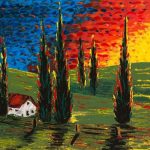Marc Chagall’s Bible Series: How the Artist Brought the Bible to Life
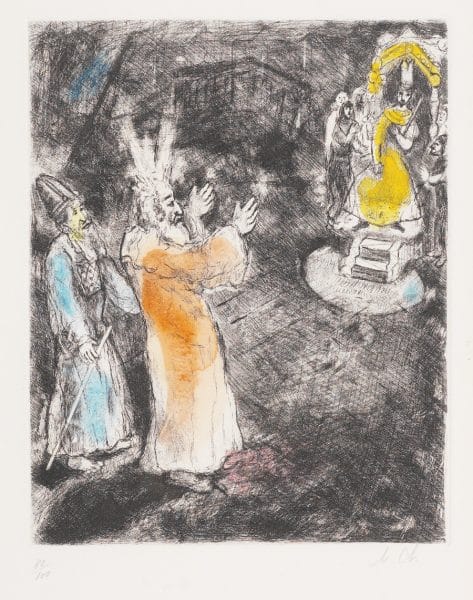
“Moses and Pharaoh” (1931-39), Marc Chagall
Now considered a pioneer of modernism, 20th-century artist artist Marc Chagall risked damaging that reputation when he created a graphic series based on one of art’s most ancient subjects: The Bible.
The end result, however, was a series of 105 incredible etchings and engravings that many art historians consider to be one of the greatest artistic achievements in modern times. As noted art historian Meyer Schapiro put it:
“If we had nothing of Chagall but his Bible, he would be for us a great modern artist.”
Chagall’s Bible: In the Beginning
The idea of Chagall, a Russian-Jewish artist, taking on the monumental task of illustrating the Bible originated with famed art dealer and publisher Ambroise Vollard. The French dealer had famously helped elevate the careers of artists like Pablo Picasso, Paul Cezanne, and Pierre-Auguste Renoir.
Vollard had previously worked with Chagall on illustrating a Russian novel and a collection of fables. In 1931, Vollard once again approached Chagall, who was living in Paris at the time, this time with the idea of creating a series of etchings based on the Bible, specifically the Old Testament.
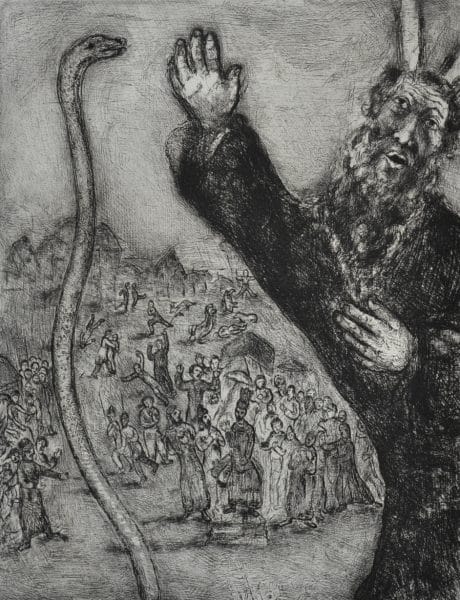
“Moses and the Serpent” (1956), Marc Chagall
In preparation for this commission, Chagall traveled to Palestine in the spring of 1931. The two-month trip became a life-altering experience for the artist, who had always been fascinated by the Bible and religion.
“Ever since my earliest youth, I have been fascinated with the Bible. I have always believed that it is the greatest source of poetry of all time,” Chagall said. “I have sought its reflection in life and art. The Bible is life, an echo of nature, and this is the secret I have endeavored to transmit.”
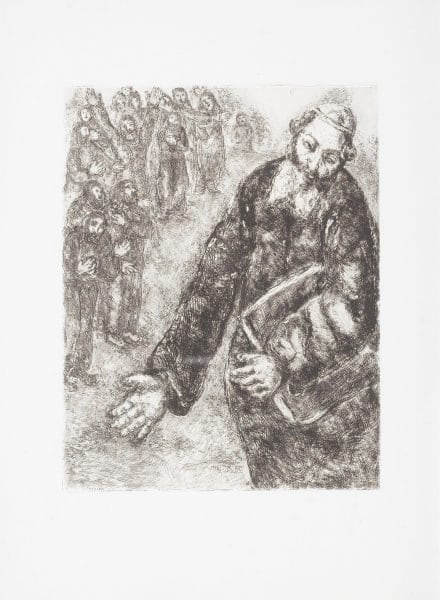
“Josue lit les Paroles de la Loi” (Joshua Reads the Words of the Law)
(1931-39), Marc Chagall
Upon his return to France, Chagall immediately began working on the series, choosing etching and engraving as his medium. His passion for the project even led him to Amsterdam, where he intently studied the biblical art created by Rembrandt van Rijn and El Greco.
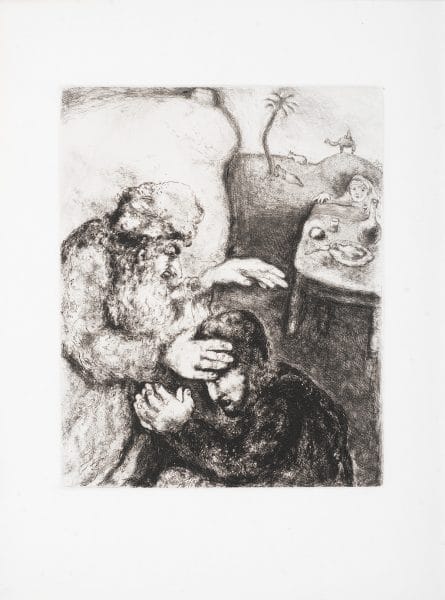
“Jacob Beni par Issac”
(Jacob Blessed by Isaac) (1931-39), Marc Chagall
Between 1931 and 1939, Chagall completed 65 plates for his etchings and engravings. Unfortunately, calamity would strike before he could complete the series. In July 1939, Vollard died in an auto accident. This tragedy, coupled with World War II spreading across Europe, forced the Bible project to a halt.
But the encroaching war did more than threaten Chagall’s progress on his Bible series—it also threatened his very life.
Exodus from France
As Adolf Hitler and his Nazi party gained power in Germany, they began to enact public campaigns against modern art, labeling art that was abstract and non-representational as “degenerate.” This also included works created by Jewish artists, making Chagall a perfect target.
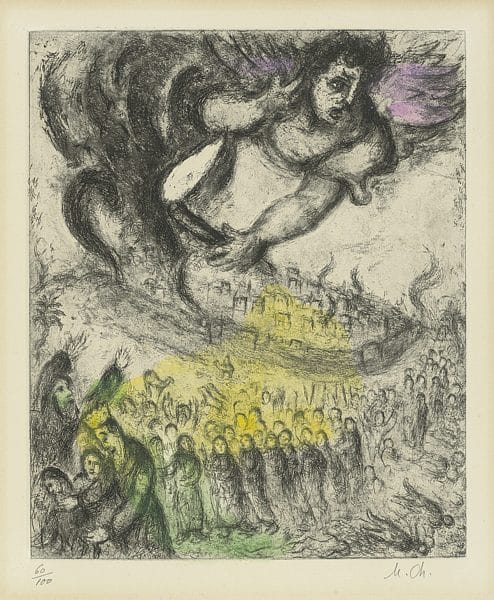
“Prise de Jerusalem”
(Capture of Jerusalem) (1931-56), Marc Chagall
However, when Germany invaded and occupied France, Chagall remained, refusing to leave the country he loved. France soon became dangerous for Jews like himself.
In October 1940, the government began approving anti-Semitic laws, and Chagall and his wife realized they needed to flee. They could only go to the United States, but they were unable to afford the fees necessary for passage to New York.
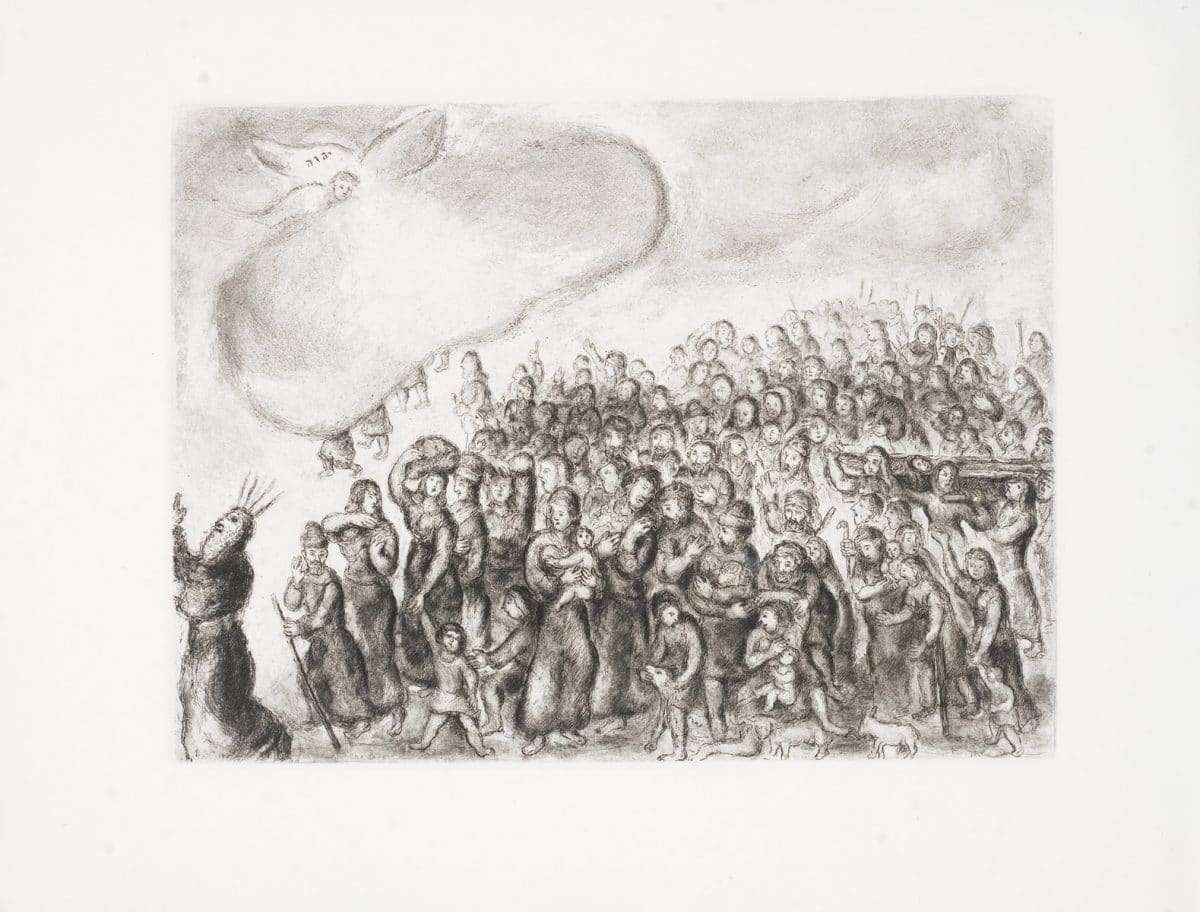
“La Sortie d’Egypte”
(The Exodus from Egypt)
1931-39
Thankfully, an American journalist named Varian Fry was operating a rescue network within France. Chagall’s name was added to a list of more than 2,000 other prominent artists whose lives were at risk. In May 1941, Chagall and his family left Europe and arrived in New York a month later.
Finishing Chagall’s Bible
During their time in the United State, Chagall’s wife, Bella, died due to illness in 1944. Grief-stricken, Chagall stopped painting for months. Despite these personal tragedies, Chagall’s fame in the art world continued to grow. By 1946, he had become internationally recognized, inspiring an exhibition at New York’s Museum of Modern art that showcased his artwork from the past 40 years.
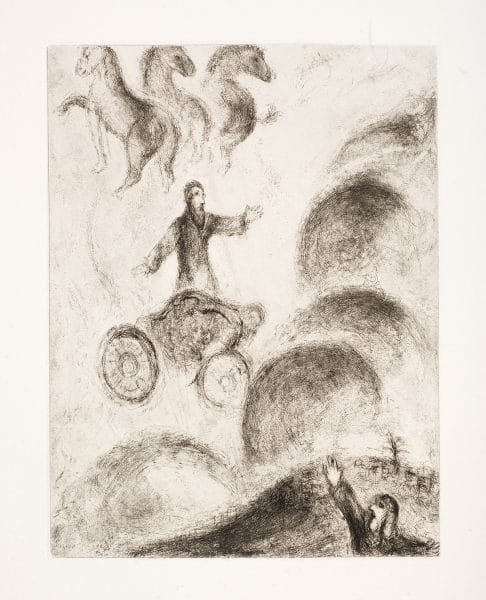
“Elie Enleve au Ciel”
(Elijah Carried Off to Heaven), (1931-39)
Chagall returned to France in 1948, and in July 1952 married his secretary, Valentina “Vava” Brodsky. That same year, Chagall finally resumed his work on the project Vollard had commissioned 25 years ago. He continued working on the Bible Series for another four years, completing another 40 etchings by 1956.
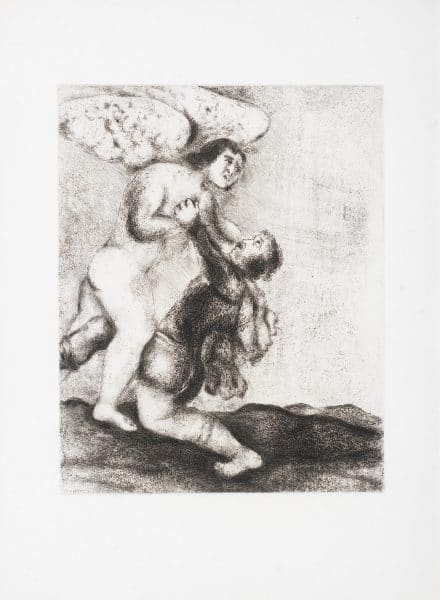
“La Lutte avec l’Ange (Wrestling with the Angel) (1931-39), Marc Chagall
The etching plates were first printed in the studio of Maurice Potin and later at Raymond Haasen’s studio. Once the process was complete, the copper plates were cancelled and given to the Musee National Message Biblique in Nice by Chagall and Vava.
The results were 275 signed and numbered portfolios and 20 hors commerce portfolios. An additional 100 sets of etchings on paper featured hand coloring and were initialed by Chagall in pencil.
Chagall’s Biblical Visions
Chagall’s Bible series covered a wide variety of stories from the Old Testament, ranging from the creation of man and Noah’s ark to Moses invoking plagues upon Egypt to convince the Pharaoh to free his people. Each one bears his unique artistic vision, blending his Jewish heritage, imagination, and groundbreaking art style with the familiar stories and passages of the Bible.
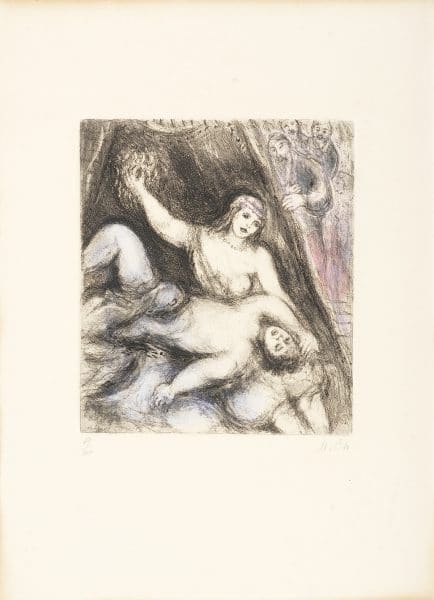
“Samson et Dalila”
(Samson and Delilah) (1931-39) Marc Chagall
Schapiro made the observation that Chagall was the ideal artist to have undertaken the task:
“He has represented themes of an older tradition not in a spirit of curiosity or artifice, but with noble devotion. Although these etchings are marvels in patience, scrupulous craftsmanship, in almost every image we experience the precise note of his emotion, his awe or sadness or joy, which is voiced in the melody of shapes and the tonal scale peculiar to each conception.”
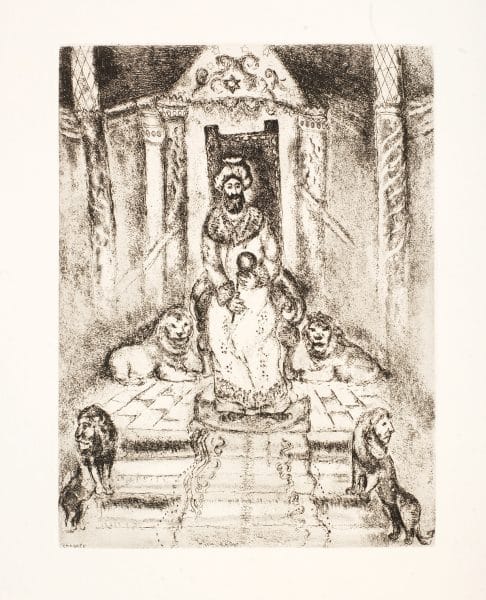
“Salomon sur son Trone”
(Solomon on His Throne)
(1931-39), Mar Chagall
Chagall had approached the project wholeheartedly. He saw the narrative of the Old Testament as a series of recurring images and themes to interpret, so instead of coldly illustrating the text, he instilled each engraving with human emotion and spirituality.
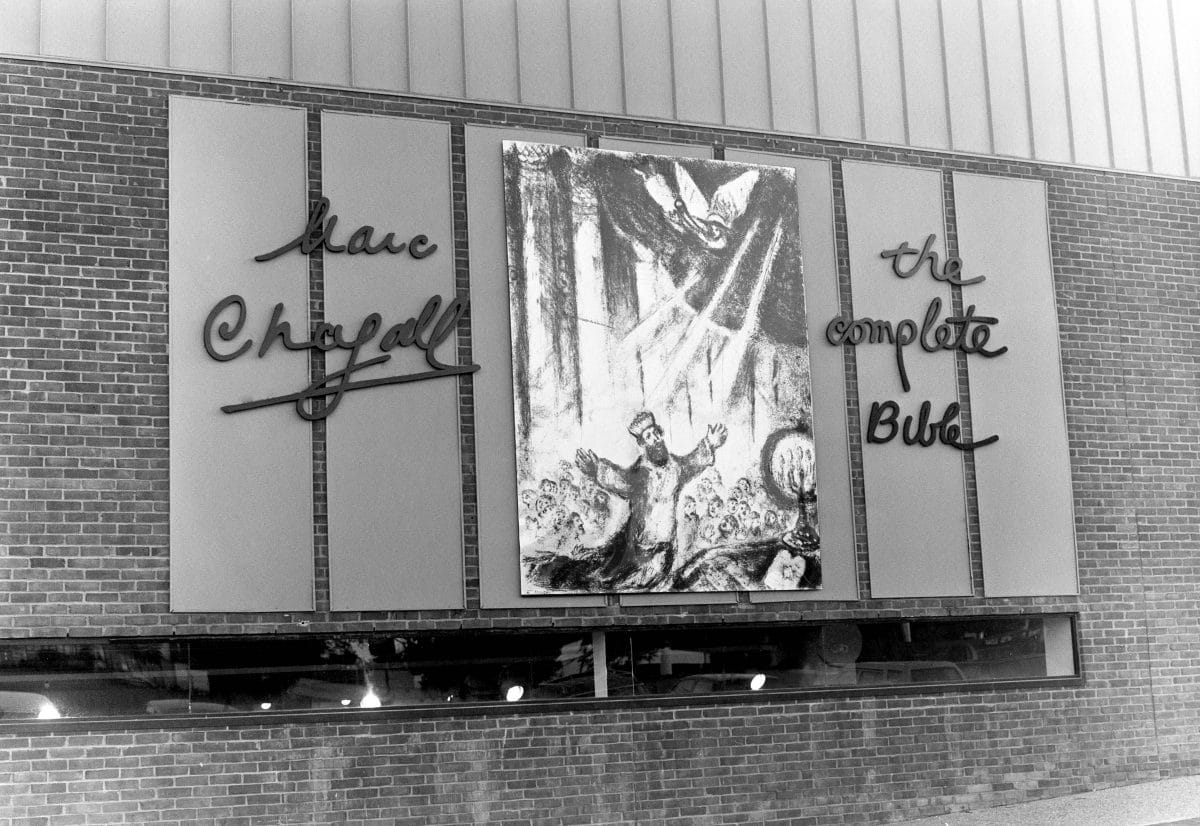
A photo from Park West Gallery’s archives showing the gallery’s Chagall Bible series exhibition
In fact, throughout his career, Chagall sought the aid of “God-made” beauty to determine whether his art was worthy. Park West Gallery Director Morris Shapiro describes Chagall’s unique method of determining whether his art was worthy like this:
“When Chagall made a work of art, he said he would put it up against a God-made object like a flower or a tree, and if it clashed, it wasn’t art,” Shapiro says. “He also went on to say that when he created his art, he was competing with the beauty of flowers, and failing.”
The Bible series by Chagall is regarded as one of the artist’s greatest masterpieces, and one of the 20th century’s best example of engravings.
For information on how to collect works from Marc Chagall’s Bible series as well as other works by Chagall, contact our gallery consultants at (800) 521-9654 ext. 4 or sales@parkwestgallery.com.





